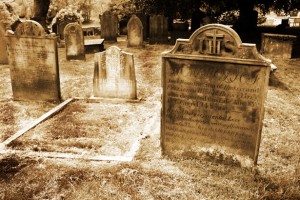 You see them all over Rhode Island: white rectangular placards on metal poles — like bus stop signs — beside a highway, near a school, tucked between houses or in unexpected corners of land. They’re markers for historical cemeteries. And RI — a state of only 1,214 square miles — has more than 3,000.
You see them all over Rhode Island: white rectangular placards on metal poles — like bus stop signs — beside a highway, near a school, tucked between houses or in unexpected corners of land. They’re markers for historical cemeteries. And RI — a state of only 1,214 square miles — has more than 3,000.
Pegee Malcolm, chairwoman of the Rhode Island Historical Cemetery Commission, makes one condition before she talks to the press: “As long as you don’t make cemeteries spooky.”
Makes sense — ghoulish thrill-seeking is often connected to vandalism in these historic sites.
In January 2018, Grace Cemetery, an historical cemetery in Providence, suffered the latest of repeated incidences of toppled headstones, and in 2011, a late-night party and campfire in one of Rhode Island’s oldest cemeteries (Newport’s Common Burial Ground) led to damage to almost 300 grave markers.
As chairwoman, Malcolm raises awareness of these “living history” monuments across our state and coordinates volunteer efforts to keep historic cemeteries accessible and well preserved. The need for volunteers, says Malcolm, is especially keen in autumn, when historic cemeteries can get overrun with falling leaves, broken tree branches and encroaching weeds.
“Nature takes over,” says Malcolm, “and if people can’t take the responsibility to clean [the cemetery] or take care of it, then it disappears.”
Malcolm says she welcomes volunteers young and old and in between: “We’ve had 6-year-olds with rakes, and if you’re old, you can hold a bag for someone else to put leaves in. It’s not something that you need to be big and strong to do. You just need to have a commitment.”
Rhode Island historical cemeteries — so designated because at least one person there was buried at least 100 years ago — come in all shapes and sizes. An historical cemetery can contain thousands of headstones and markers or as few as 10, or five or one. Historical cemeteries are so scattershot and often found in odd places because not that long ago, RI was mostly farmland, on which families buried their own.
Regardless of their size or location, state historical cemeteries are points of interest for their beauty and their connection to Rhode Island’s past. They provide a walking tour of state history, where at every turn one sees family names that were given to Rhode Island streets, schools and institutions: Brown, Butler, Angell and more.
Finding Rhode Island historical cemeteries, cataloging them, recording names, cleaning markers, repairing headstones and preserving the grounds is all done by volunteers. And could the Historical Cemetery Commission use more volunteers?
“Absolutely!” Malcolm cries, adding with a laugh: “Did I say that fast enough?”
For information on how you can get involved, contact Pegee Malcolm at pmalcolm@cox.net or call the RI Historical Cemetery Commission at 401-467-8142. Visit the Commission’s website (rihistoriccemeteries.org) to look up cemeteries by name and town.


